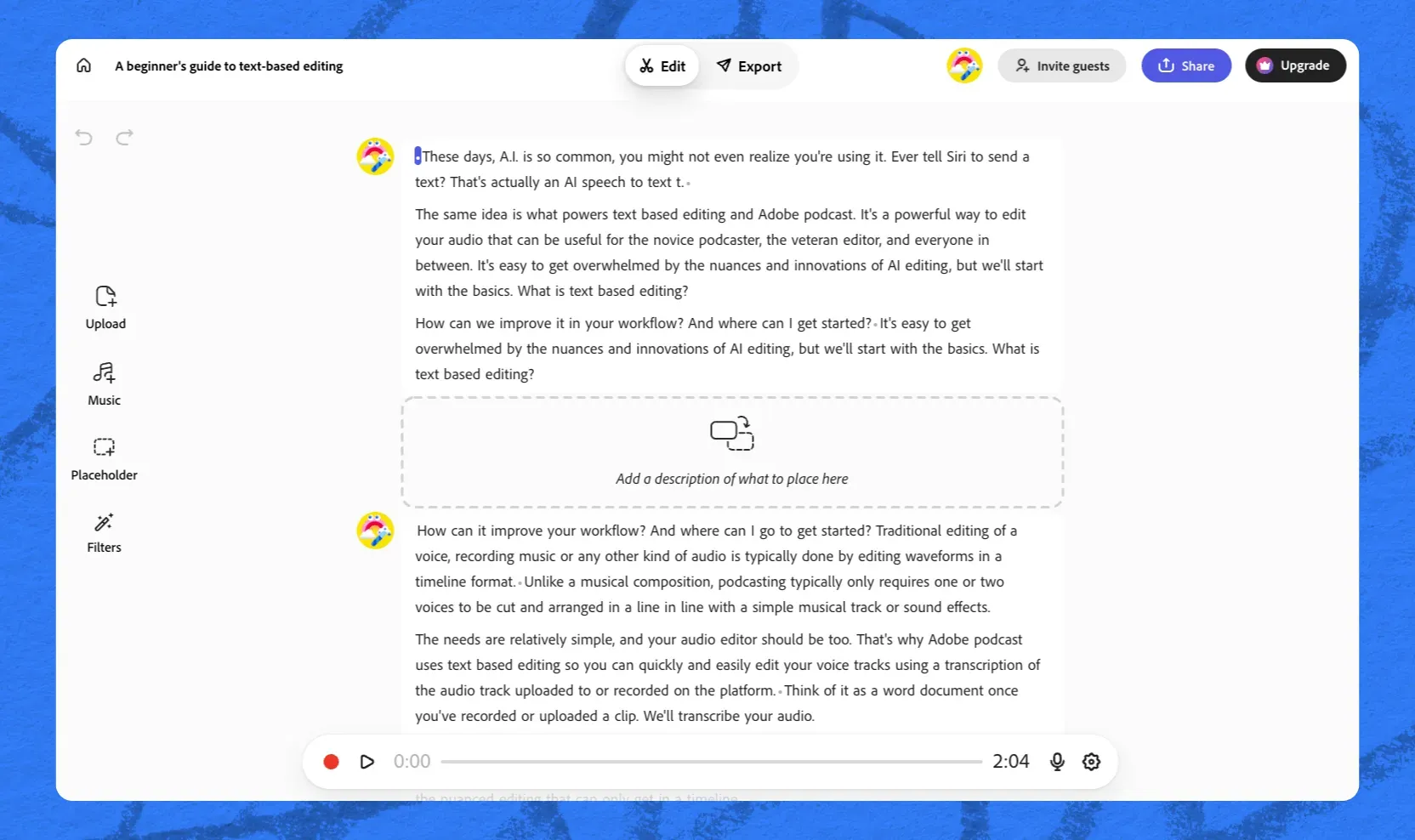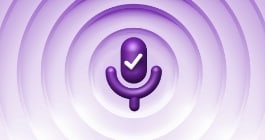Unlock more with the Adobe Podcast Premium plan 
- Video support for MP4, MOV, and more
- Bulk upload files for enhancement
- Adjust strength for a more natural sound
- Enhance up to 4 hours a day, files up to 1 GB
- No download limits on Studio projects
- Download original recordings, speaker-separated
- Customize audiograms and captions with themes
- Upload custom backgrounds for audiograms
- All Premium features for design
Enhance Speech
Studio
Design with Adobe Express Premium
How to structure your story
Creating a blueprint for your podcast storyline.

Last updated: April 6, 2025
Author: Harmony Jiroudek, Product education & community manager
Unfortunately, there’s no “one size fits all” when it comes to finding a winning podcast formula. However, there are some key elements that are important to include when it comes to planning your show. They may not launch you into stardom, but some pre-work can definitely help save you time in the long run.
Do your future self a favor and spend some time thinking about your content structure. Experience and feedback should eventually help guide you to refine your goals, but here we’ll cover the basics of creating a solid base to bring your storytelling to life.
Start with a clear concept
Before you jump in and record a new podcast, your first order of business should be setting a distinct goal for what your content will cover. You likely have something in mind, but if not, ask yourself questions like:
- Do I want to teach people about something?
- Is entertainment—like being comical or fun—my main focus?
- Will my show rely on conversations with guests?
- How much do I have to say about topics I’m considering?
While dialing in your concept, you also need to keep your audience in mind. Who you want to target and who actually picks up content can vary, so it’s essential to study your audience to figure out what makes them tick based on the type of content you plan to produce.
We were able to sit down and chat with Kevin O’Connell, editor of the (currently) #1 podcast, The Mel Robbins Podcast. Here are his thoughts on how to find out what your audience likes:
A really fun exercise is actually creating characters and saying, okay, this is Sally. Sally really loves this type of lifestyle. This is how she spends her time. This is what her day to day life is generally. And these are the ways in which I think she would connect to this idea.
Then you go to the next one. You're like, all right, and there's this dude, Joe. And I think the same thing about him. He's going to really connect to these ideas because X, Y, and Z. Are they the type of person who's going to listen to my three hour rant? Or do they want a 20 minute concise thing about my topic. About birdwatching, or whatever it might be.
So you create these personas. Then you go and find them in real life like, “Oh my gosh, my cousin is Sally.” That's like the whole way up. Let me go and FaceTime my cousin Sally and talk to them. Why they might be interested in this topic.
That's my pinnacle of listener research.
As you develop and refine your concept, focus on what you want your audience to remember. Engaged listeners—whether providing pure entertainment or discussing fascinating concepts—are more likely to become regular listeners and share your program with others.
Breakdown the script
Once you’ve ironed out your concept, you can begin planning your content series and making scripts for individual episodes.
Podcasts may come in all flavors, but there are a couple of key guiding principles that benefit almost all programs.
- You need a hook. Similar to a catchy chorus in a song, you need to pull people into your program early. You want to have something recognizable in the first 30 seconds of your show, so make sure to bake familiarity into your intros. You can do this with music, a slogan, or sound effects; whatever works best for the story you’re trying to tell.
- Content needs to flow. Think about how it can feel when someone tells you a story, but jumps around, adding in details that often begin with, “Oh, I forgot! Before that happened, this happened!” Remember that listeners aren’t listening from inside your head and logical structures are best for most storytelling efforts.
So, with that in mind, here are a few story beats that can help you create and expand upon your ideas to build sensible arcs:
Step 1: Introduce your thesis
Most stories tend to revolve around some problem that’s later resolved near the conclusion. So, the best way to start your podcast is by introducing your conflict. Make sure listeners get the needed context that explains why this matters.
Step 2: Develop your arc
Any good storyteller knows how much pacing matters. You need to space out key points in a story to build tension and make keep your listeners engaged. Even if it’s non-narrative or an interview, spacing out talking points and leaving some elbow room for the unknown will help with keeping a good flow.
Step 3: Reach a conclusion
Don’t rush the ending. If you’ve put enough work into the planning stage, you will be able to reach a smooth conclusion. Things don’t have to be wrapped up to perfection, but hopefully you can find a way to tie things together.
Optional: Call to action
Some podcasts will have a Call to Action (CTA) that urges listeners to do something such as purchase a product or take a step towards something. These usually work best when short, sweet, and after the end of a program, but this can vary depending on goals and the nature of the CTA.
While these tips will serve most content formats, there is room for exceptions, but with a few words of caution.
If you want to try your hand at something non-linear, like the podcast equivalent of a Quentin Tarantino film, know that it’s entirely possible. Just remember that structure is just as important, so thoughtful planning will be key to ensuring you’re satisfying fans and avoiding immersion-breaking plot holes!
Tips to help structure your content
Now that we’ve lectured on the theory and practices of structuring content, we’ll quickly cover a few tips to help you with the process.

Adobe Podcast Studio has a simple placeholder tool (appropriately named Placeholder) that allows you to quickly put a visible segment in your transcription where you can remind yourself to add or alter content later.
- Use placeholders for unfinished ideas. To avoid getting stuck and losing momentum, Placeholders in Studio (pictured above) can help you easily add markup as reminders to revisit areas later.
- Leave a little extra room. For storytelling and conversational formats, extra space can help accommodate spontaneity and some venturing off the beaten path.
- Don’t overscript. Little reminders can help podcast host delivery sound more natural, whereas too much scripting can sometimes sound robotic.
- Add music. You almost certainly remember at least one theme song from a favorite childhood cartoon—try this for your own content by adding royalty-free music using the Music feature in Studio, or uploading custom tracks.
- Easily polish your content with text-based editing in Studio. Audio you record or upload is automatically transcribed, allowing you to easily edit your content with text-based editing baked right into Studio!
- Get feedback. You surely want to know what your family and friends think, so share your podcast and ask for feedback. Just remember to be accepting of fair criticisms!
Plan a little to make the best possible podcast
Ask anyone who successfully completes big projects and most will tell you that great planning can save a ton of time and prevent unneeded frustration down the road.
Your process can (and should) evolve with time. But if you’re just starting out, break out a pen and paper and get started with figuring out your structure.
About the author: Harmony leads product education and community for Adobe Podcast. As a musician and educator, she brings a human-centered approach to helping creators learn, connect, and grow with powerful audio tools. Her passion lies in making creative technology feel accessible, empowering, and inspiring.



